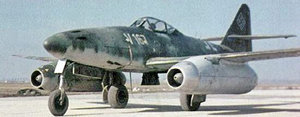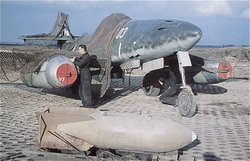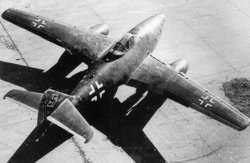Messerschmitt Me 262
|
|
| Messerschmitt Me 262A-1a | ||
|---|---|---|

| ||
| Description | ||
| Role | Fighter/Bomber | |
| Crew | One, pilot | |
| First flight | July 18 1942 | |
| Manufacturer | Messerschmitt | |
| Dimensions | ||
| Length | 10.58 m | 34 ft 9 in |
| Wingspan | 12.5 m | 41 ft 0 in |
| Height | 3.83 m | 12 ft 7 in |
| Wing area | 21.7 m² | 234 ft² |
| Weights | ||
| Empty | 3,800 kg | 8,400 lb |
| Loaded | ||
| Maximum takeoff | 6,400 kg | 14,100 lb |
| Powerplant | ||
| Engines | 2x Jumo 004B-1 turbojets | |
| Thrust | 18 kN | 4050 lbf |
| Performance | ||
| Maximum speed | 870 km/h | 540 mph |
| Range | 1050 km | 650 miles |
| Service ceiling | 11,450 m | 37,600 ft |
| Rate of climb | 1,200 m/min | 3,900 ft/min |
| Armament | ||
| Guns | 4 x 30 mm MK 108 cannons | |
| Bombs | ||
| Rockets | 24 x 55 mm R4M rockets | |
The Messerschmitt Me 262 Schwalbe (Swallow) was the first operational jet powered aircraft. It was mass-produced in World War II and saw action from late 1944 in bomber/reconnaissance and fighter/interceptor roles. German pilots nicknamed it the Turbo, while to the Allies it was the Stormbird, or in radio code, "blow job", in reference to its jet engines. Although the Me 262 had a negligible impact on the course of the war - shooting down an estimated 150 Allied aircraft for the loss of 100 Me 262s, the majority of aircraft grounded for lack of fuel - the jet was both well-known and highly influential on post-war aircraft development.
| Contents |
Development
Although often viewed as a last ditch superweapon, the Me 262 was already being developed as project P.1065 before the start of WWII. Plans were first drawn up in April 1939, and the original design was very similar to the plane that would eventually enter service.
During development, when an increase of the weight of the still unfinished jet engines was anticipated in March 1940, Messerschmitt used this as an opportunity to turn the Me 262 into a swept-wing fighter by sweeping back the outer wings. In 1942, the leading edges of the inner wings were extended, too, to turn the Me 262 into a true swept-wing aircraft. Swept wings had been proposed as early as 1935 by Adolph Busemann, and Willy Messerschmitt had researched the topic from 1940. In April 1941, he actually proposed to fit a 35° swept wing (Pfeilflügel II) to the Me 262. Though this suggestion wasn't implemented, he continued this line of thought with the projected HG II and HG III high-speed derivatives of the Me 262 in 1944, which were designed with a 35° and 45° wing sweep respectively.
The first test flights began in April 1941, but since the BMW 003 turbojets were not ready for fitting, a conventional Junkers Jumo 210 engine was mounted in the nose, driving a propeller, to test the airframe. When the BMW 003 engines were finally installed the Jumo was retained for safety which proved wise as both 003s failed during the first flight and the pilot had to land using the nose mounted engine alone.
The third prototype airframe became a true jet plane when it flew on July 18 1942 in Leipheim near Günzburg, Germany, piloted by Fritz Wendel. The 003 engines which were proving unreliable were replaced by the newly available Junkers Jumo 004.
Test flights continued over the next year but the engines continued to be unreliable. Although airframe modifications were completed by 1942, production never began until 1944 when the production engines — which due to the shortage of strategic materials like tungsten had to be completely redesigned to employ alloys of inferior temperature resistance — finally started to work.
Jet engines have less thrust at low speed than piston or turboprop engines. Acceleration is relatively poor and for the Me 262 it was worse because all early jet engines responded only slowly to throttle changes. Conversely, the higher power of jet engines at higher speeds meant the Me 262 enjoyed a much higher climb speed. Used tactically, this gave the jet fighter an even greater speed advantage than level flight at top speed.
Operationally, the Me 262 had an endurance of 60 to 90 minutes.
Combat overview
Despite its deficiencies, the plane was clearly pointing to the end of the propeller aircraft as a fighting machine. Once airborne it quickly accelerated to speeds well over 800 km/h, over 150 km/h faster than anything else in the air.
Many accounts from Allied bomber crews cited that they were horrified by the speed of the Me 262. Allied accounts also state some level of amazement and awe: The idea of an extremely fast propeller-less aircraft was difficult to imagine at the time, let alone experience. While Allied intelligence was aware of the German jet development, not all combat units were informed about the existence of the Me 262, contributing to the Allied amazement.
Anti-bomber tactics
The standard approach against bomber formations, which were travelling along at cruise speed, called for the Me 262 to approach the bombers from the rear at a higher altiude, diving in below the bombers to get additional speed before zooming up again to their level and opening fire with its four 30 mm cannon at 600 m range.
Reportedly, Allied bomber gunner were finding that their electric gun turrets had problems tracking the jets. However, due to the jets' straight line approach, traverse rates were actually not as important as target acquisition itself, which was difficult because the jets closed into firing range very quickly and had to remain in firing position only very briefly using their standard attack profile.
On September 1, 1944, General Spaatz expressed the fear that if greater numbers of German jets were fielded, they could inflict losses to the USAAF bombers heavy enough to cause cancellation of the Allied daylight bombing offensive.
Counter-jet tactics
Tactics against the Me 262 developed quickly to find ways of defeating it despite its insurmountable speed. Allied bomber escort fighters (specifically P-51s) would fly high above the bombers to gain extra speed in a dive down to protect the bombers, thus reduce the speed advantage of the Me262. The Me262 was less maneuverable than the P-51 and trained allied pilots could catch up to a turning Me262; but the only reliable way of dealing with the jets was to attack them in the take-off and landing phase of their flight, and on the ground. Accordingly, Luftwaffe air fields that were recognized as jet bases were frequently bombed by medium bombers, and Allied fighters patrolled over the fields to attack jets that were trying to land on their bases. The Luftwaffe countered these moves by installing Flak alleys along the approach lines in order to protect the Me 262s from the ground, and providing top cover with conventional fighters during the take-off and landing phase.
The US Army demanded production far ahead of schedule for the P-80 to provide a allied jet fighter that could match the Me262, but had to ground the P-80 after one of the four US jets deployed to Europe was wrecked in a fatal accident. Other Allied fighters who encountered the Me 262 included the British Hawker Tempest Mk.V and the Soviet Lavochkin La-7. The Tempest was the first Allied plane to shoot down a Me262, and won number of victories over these jet fighters, while the Lavochkin was the only Soviet fighter to encounter a German jet, with La-7 ace Ivan Nikitovich Kozhedub figthing and downing one Me262 jet on February 15, 1945 over eastern Germany. Kozhedub apparently later said that his success was mainly due to the Me262 pilot attempting to out-turn his more manoeuverable plane.
High speed research
Me262cockpit_color.jpg
Willy Messerschmitt regarded the Me 262 as it went into production only as an interim type. His interest in high-speed flight that had led him to initiate work on swept wings starting in 1940 is evident from the advanced developments he had on his drawing board in 1944. While the Me 262 HG I (Hochgeschwindigkeit - high speed) that was actually flight-tested in 1944 had only small changes compared to combat aircraft, most notably a low-profiled canopy to reduce drag, the HG II and HG III designs were far more radical. The projected HG II variant combined the low-drag canopy with a 35° wing sweep and a butterfly tail. The HG III aircraft had a conventional tail, but a 45° wing sweep and the jet turbines embedded in the wing root.
Messerschmitt also conducted a series of carefully controlled flight tests with the series production Me 262. In these dive tests, it was established that the Me 262 was out of control in a dive at Mach 0.86, and that higher Mach numbers would lead to a nose-down trim that could not be countered by the pilot. The resulting steepening of the dive would lead to even higher speeds and disintegration of the airframe due to excessive negative g loads.
The HG series of Me 262 derivatives was estimated to be capable of reaching transsonic Mach numbers in level flight, with the top speed of the HG III being projected as Mach 0.96 at 6 km altitude. Despite the necessity to gain experience in high-speed flight for the HG II and III designs, Messerschmitt undertook no attempts to exceed the Mach 0.86 limit for the Me 262.
After the war, the Royal Aircraft Establishment — at that time one of the leading instituations in high-speed research — re-tested the Me 262 to help with the British attempts at breaking the sound barrier. The RAE achieved speeds of up to Mach 0.84 and confirmed the results from the Messerschmitt dive tests as accurate. No attempts were made to exceed the Mach limit established by Messerschmitt.
After Willy Messerschmitt's death, the former Me 262 pilot Hans Guido Mutke claimed to be the first person to break the sound barrier on April 9 1945 in a Me 262. This claim is only based on Mutke's memory of the airspeed indicator reading and is disputed.
Operations
Initially only bomber units were equipped with the Me 262 (at Hitler's insistence) despite the aircraft being designed as a fighter. Due to the characteristics of jet engines, dog fighting at low speeds had to be avoided. Good pilots made only small turns, never allowing speed to drop too much, attacking bomber formations on long, zooming passes.
In the end, the overwhelming numbers of allied planes meant that the jets had no overall effect on the war. On March 18, 1945, 37 Me 262s intercepted a force of 1,221 bombers and 632 escorting fighters. They managed to shoot down 12 bombers and one fighter for the loss of three Me 262s. Although a four to one ratio was exactly what the Luftwaffe was dreaming about, it represented only one per cent of the attacking force — more were lost to mechanical problems.
Two-seater "B" variants of the Me 262 had been produced as night-fighters, complete with on-board radar and "deerhorn" antennae. Whether these ever saw combat is debated. In either case, few veteran night-fighter pilots expressed much enthusiasm for the idea of adding a second crewmember.
Although the British Gloster Meteor jet had entered service in August 1944, the two aircraft never engaged in combat; the Meteor was initially restricted to the skies over Britain (where it engaged incoming V-1 flying bombs), whilst its later use over Europe did not result in any combat. The first jet-jet dogfights would thus not take place until the Korean War.
After the end of the war the Me 262 as well as other advanced German technology was quickly swept up by both the Soviets and the Americans. Many Me 262s were found in working condition by both sides and were confiscated. These aircraft were extensively studied, aiding development of early US and Soviet jet fighters. The F-86 Sabre and the Sukhoi Su-9 (1946) were directly influenced by the Me 262.
The Czechoslovakian aircraft industry continued to produce single-seater and two-seater variants of the Me 262 after WWII. These were kept flying as late as 1957. One of them is on display at the Prague Aero museum.
In January, 2003, the American Me 262 Project (http://www.stormbirds.com/project/index.html) (formerly known as Classic Fighter Industries, Inc.) successfully flight tested a near-exact replica of the Me 262 B-1c two-place variant, powered by GE J-85 engines. Flight testing of the first newly-manufactured Me 262 A-1c (single seat) variant was scheduled for early June, 2005.
Variants
- A-1a Schwalbe - production version Jaeger (fighter) and Jabo (fighter bomber).
- A-1a/U1 - single prototype with two additional guns in nose, for total of six.
- A-1a/U2 - single prototype with additional avionics for all-weather operation.
- A-1a/U3 - reconnaissance version modified in small numbers.
- A-1a/U4 - two prototypes with 50 mm tank cannons in nose.
- A-1b - as A-1a but powered with BMW 003 engines. Few if any built.
- A-2a Sturmvogel - definitive blitzbomber version with only two guns.
- A-2a/U1 - single prototype with advanced bombsight.
- A-2a/U2 - two prototypes with glazed nose for accommodating a bombadier.
- A-3a - proposed ground attack version.
- A-4a - reconnaissance version.
- A-5a - definitive reconnaissance version used in small numbers at end of the war.
- B-1a - two-seat trainer.
Me262_02.jpg
- B-1a/U1 - small number of prototype night fighters adapted from trainers.
- B-2 - proposed night fighter version with stretched fuselage.
- C-1a - single prototype of rocket-boosted interceptor with Walter rocket in tail.
- C-2b - single prototype of rocket-boosted interceptor with BMW rockets mounted in engine nacelles.
- C-3a - single prototype of rocket-boosted interceptor with Walter rockets in belly pack.
- D-1 - proposed variant to carry Jagdfaust mortars.
- E-1 - proposed cannon-armed variant based on A-1a/U4.
- E-2 - proposed rocket-armed variant carrying 48 R4M rockets.
Japanese design patterned after the Me 262:
Post-war variants
- Avia S-92 - Czech built A-1a
- Avia CS-92 - Czech built B-1a
- A-1c - American privately built replica based on A-1a configuration
- B-1c - American privately built replica based on B-1a configuration
- A/B-1c - American privately built replica convertible between A-1a and B-1a configuration
See also
Trivia
- The heavy metal band Blue Öyster Cult paid tribute to the Me 262 as the "Prince of Turbojets" with their song "Me 262" found on their Secret Treaties album.
External links
- Stormbirds - Official home of the the Me 262 Project, and several Me 262 related features (http://www.stormbirds.com)
- Air Vectors - The Messerschmitt Me 262 Schwalbe/Sturmvogel (http://www.vectorsite.net/avme262.html)
- http://www.luftwaffepics.com/lme2621.htm
|
Lists of Aircraft | Aircraft manufacturers | Aircraft engines | Aircraft engine manufacturers Airports | Airlines | Air forces | Aircraft weapons | Missiles | Timeline of aviation |
fr:Messerschmitt Me 262 ja:メッサーシュミットMe262 nl:Messerschmitt Me 262 no:Messerschmitt Me 262 pl:Messerschmitt Me 262 fi:Messerschmitt Me 262 he:מסרשמיט Me-262 sv:Messerschmitt Me 262


